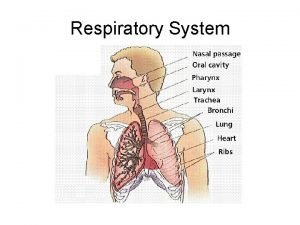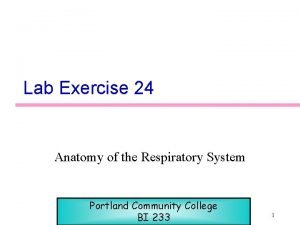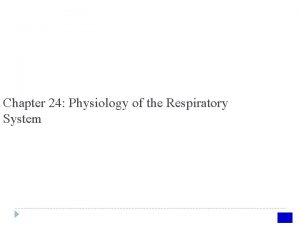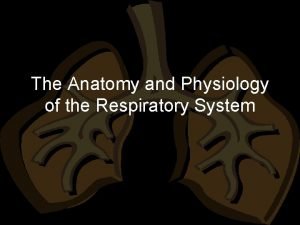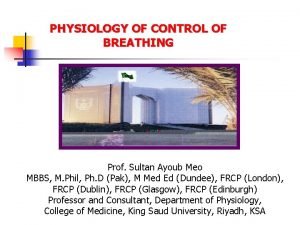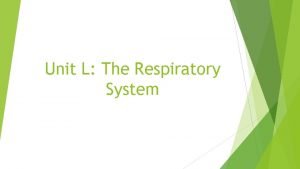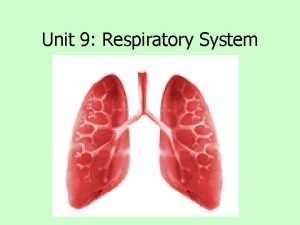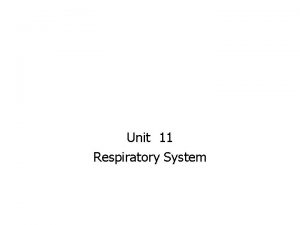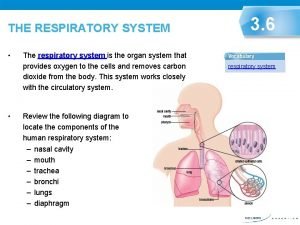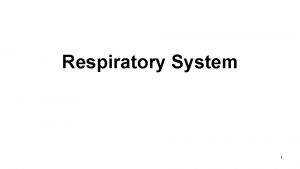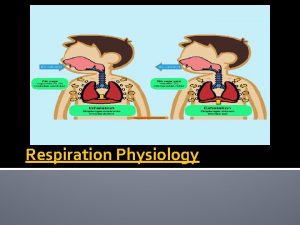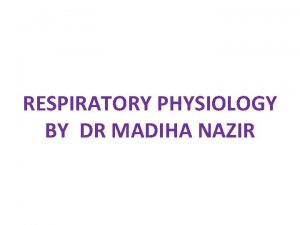The Respiratory System Physiology Events of Respiration Physiology



















- Slides: 19

The Respiratory System Physiology

Events of Respiration- Physiology · Pulmonary ventilation – moving air in and out of the lungs · External respiration – gas exchange between pulmonary blood and alveoli Copyright © 2003 Pearson Education, Inc. publishing as Benjamin Cummings Slide 13. 20 a

Mechanics of Breathing (Pulmonary Ventilation) Completely mechanical process depends on volume changes in the thoracic cavity Volume changes lead to pressure changes, which lead to the flow of gases to equalize pressure Copyright © 2003 Pearson Education, Inc. publishing as Benjamin Cummings Slide 13. 21 a

Mechanics of Breathing (Pulmonary Ventilation) Two phases ·Inspiration – flow of air into lung ·Expiration – air leaving lung Copyright © 2003 Pearson Education, Inc. publishing as Benjamin Cummings Slide 13. 21 b

Inspiration · Diaphragm and intercostal muscles contract · The size of the thoracic cavity increases · External air is pulled into the lungs due to an increase in intrapulmonary volume Copyright © 2003 Pearson Education, Inc. publishing as Benjamin Cummings Slide 13. 22 a

Inspiration Figure 13. 7 a Copyright © 2003 Pearson Education, Inc. publishing as Benjamin Cummings Slide 13. 22 b

Exhalation · Largely a passive process which depends on natural lung elasticity · As muscles relax, air is pushed out of the lungs · Forced expiration can occur mostly by contracting internal intercostal muscles to depress the rib cage Copyright © 2003 Pearson Education, Inc. publishing as Benjamin Cummings Slide 13. 23 a

Exhalation Figure 13. 7 b Copyright © 2003 Pearson Education, Inc. publishing as Benjamin Cummings Slide 13. 23 b

Pressure Differences in the Thoracic Cavity Normal pressure within the pleural space is always negative (intrapleural pressure) Differences in lung and pleural space pressures keep lungs from collapsing Copyright © 2003 Pearson Education, Inc. publishing as Benjamin Cummings Slide 13. 24

Respiratory Volumes and Capacities Normal breathing moves about 500 ml of air with each breath (tidal volume [TV]) Many factors that affect respiratory capacity · A person’s size · Sex · Age · Physical condition Residual volume of air – after exhalation, about 1200 ml of air remains in the lungs Copyright © 2003 Pearson Education, Inc. publishing as Benjamin Cummings Slide 13. 26

Respiratory Volumes and Capacities · Inspiratory reserve volume (IRV) · Amount of air that can be taken in forcibly over the tidal volume · Usually between 2100 and 3200 ml · Expiratory reserve volume (ERV) · Amount of air that can be forcibly exhaled · Approximately 1200 ml Copyright © 2003 Pearson Education, Inc. publishing as Benjamin Cummings Slide 13. 27 a

Respiratory Volumes and Capacities Residual volume ·Air remaining in lung after expiration ·About 1200 ml Copyright © 2003 Pearson Education, Inc. publishing as Benjamin Cummings Slide 13. 27 b

Respiratory Volumes and Capacities Vital capacity · The total amount of exchangeable air · Vital capacity = TV + IRV + ERV · Dead space volume · Air that remains in conducting zone and never reaches alveoli · About 150 ml Copyright © 2003 Pearson Education, Inc. publishing as Benjamin Cummings Slide 13. 28

Respiratory Capacities Figure 13. 9 Copyright © 2003 Pearson Education, Inc. publishing as Benjamin Cummings Slide 13. 30

Factors Influencing Respiratory Rate and Depth Physical factors · Increased body temperature · Exercise · Talking · Coughing Volition (conscious control) Emotional factors Copyright © 2003 Pearson Education, Inc. publishing as Benjamin Cummings Slide 13. 38

Factors Influencing Respiratory Rate and Depth Chemical factors Carbon dioxide levels · Level of carbon dioxide in the blood is the main regulatory chemical for respiration · Increased carbon dioxide increases respiration · Changes in carbon dioxide act directly on the medulla oblongata Copyright © 2003 Pearson Education, Inc. publishing as Benjamin Cummings Slide 13. 39 a

Factors Influencing Respiratory Rate and Depth Chemical factors (continued) Oxygen levels · Changes in oxygen concentration in the blood are detected by chemoreceptor's in the aorta and carotid artery · Information is sent to the medulla oblongata Copyright © 2003 Pearson Education, Inc. publishing as Benjamin Cummings Slide 13. 39 b

Respiratory Rate Changes Throughout Life · Newborns – 40 to 80 respirations per minute · Infants – 30 respirations per minute · Age 5 – 25 respirations per minute · Adults – 12 to 18 respirations per minute Rate often increases somewhat with old age Copyright © 2003 Pearson Education, Inc. publishing as Benjamin Cummings Slide 13. 49

External Respiration, Gas Transport, and Internal Respiration Summary Figure 13. 10
 Stimulus for breathing
Stimulus for breathing Conducting zone of the respiratory system
Conducting zone of the respiratory system Larynx and trachea
Larynx and trachea Respiratory system in humans
Respiratory system in humans Digestive system circulatory system and respiratory system
Digestive system circulatory system and respiratory system External vs internal respiration
External vs internal respiration Internal vs external respiration
Internal vs external respiration What is the physiology of respiration
What is the physiology of respiration What is the physiology of respiration
What is the physiology of respiration Laynx
Laynx Primary secondary and tertiary bronchi
Primary secondary and tertiary bronchi Peripheral chemoreceptor
Peripheral chemoreceptor Mutually exclusive events vs not mutually exclusive events
Mutually exclusive events vs not mutually exclusive events How respiratory system work with circulatory system
How respiratory system work with circulatory system Circulatory system and respiratory system work together
Circulatory system and respiratory system work together Bozeman respiratory system
Bozeman respiratory system Unit 9 respiratory system
Unit 9 respiratory system Diagnostic test of respiratory system
Diagnostic test of respiratory system Respiratory system
Respiratory system What is larynx
What is larynx
